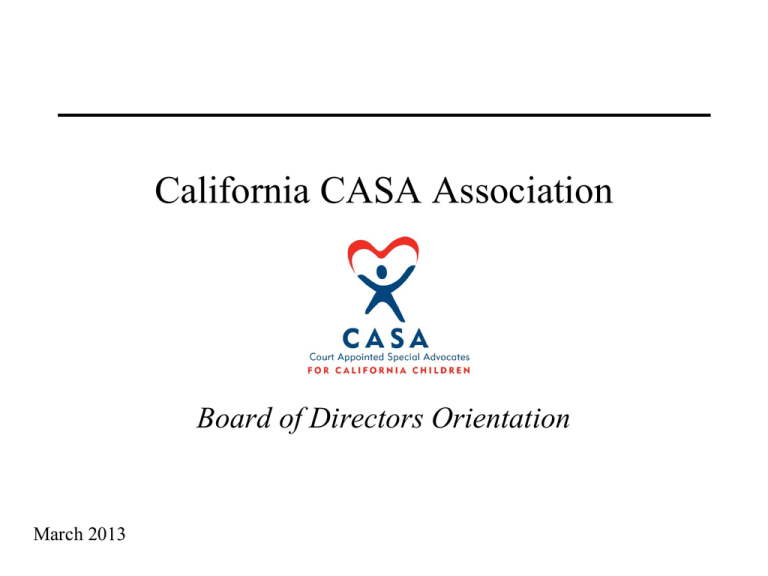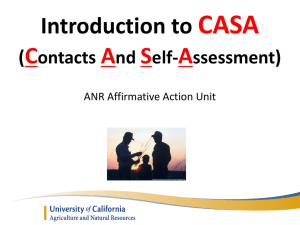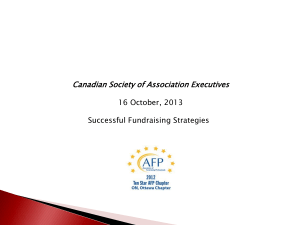Board Orientation Power Point
advertisement

California CASA Association Board of Directors Orientation March 2013 Page 1 Your Facilitators Kevin Gardner – kevin@murphygardner.com – 1-415-269-3585 Pat Bresee – patsee@earthlink.net – 1-650-369-6252 Page 2 Orientation Objectives Through this orientation you will … Learn about California CASA (CalCASA) Find out about the Board and how it functions. Discover ways to participate and become engaged in the CalCASA board. Page 3 Mission The mission of California CASA is to enhance and strengthen CASA in California and support individual programs in their efforts to provide quality advocacy services to all abused and neglected children in the juvenile courts through the use of trained volunteers. Page 4 CalCASA Program Overview We support California’s CASA programs… Provide comprehensive technical assistance such as: – Identify and promote best practices in program operation, – Facilitate non-profit program management, – Facilitate pro bono legal assistance, – Develop and disseminate CASA practice tools (curricula and other material via website, listserves, bulletins) Provide evaluation, follow-up, and training to local programs, e.g.: – Evaluate local programs at tri-annual site visits with the AOC/CFCC, – Provide any technical assistance following site visits, – Host conferences, regional trainings, etc. aimed at improving CASA efficacy . – Provide advice and referrals for resources to local programs for fundraising and access to other support potentials Page 5 CalCASA Program Overview We advocate for California’s children… Provide the CASA perspective to California’s legislation through: – Board-level Legislative Advocacy Committee, – Supporting and/or sponsoring needed legislation Bring the CASA perspective to policy forums such as; Participating in numerous state-level problem solving meetings and workgroups, CA Blue Ribbon Commission of Children in Foster Care, Child Welfare Council, Judicial Council Family/Juvenile Advisory Committee, CA Children’s Justice Task Force, National CASA leg/advocacy committee, etc. Enhance CASA practice and efficacy through gaining expertise through special initiatives, including: Educational Advocacy, Children of Incarcerated Parents, Mental Health, Family Finding and Engagement, Indian and Tribal issues (including IWCA, cultural competence, and serving Native children), Equity in serving children (cultural competence regarding race, disproportionality, sexual orientation, etc.) Page 6 CASA Network in California (2010) There are approximately 80,000 children in foster care in California. The first CASA program in California started serving children in 1978. 43 CASA programs serve 49 of California’s 58 counties, 1 Tribe (2012.) 6,660 volunteers donated 461,167 hours (a monetary value of $10.8M) to advocate for approximately 9,360 children in foster care. Statewide, total program revenue increased slightly (3%) to about $20,362,500. Median cost per child was approximately $2,165. Full-time equivalent (FTE) program staff range from 0.5 to 32 positions, with a median of 5. The median staff-to-volunteer ratio is 1:31. CASA programs serve babies, infants, and young adults: Children Served by CASA Children in Foster Care Birth – 5 years 16% 34% 6 – 10 years 22% 20% 11 – 15 years 36% 26% 16 – 17 years 20% 15% 18+ years 6% 5% Page 7 CASA Network in California (2010) CASA programs are 501(c)(3) non-profit organizations (except Alameda County.) The major revenue sources of these CASA programs in 2010 were: Corporations & Foundations $4,262,964 21% Fundraising Events $4,550,808 22% Government (Federal, State, Local) $7,123,292 35% Individual Donors $3,260,423 16% Other Sources $1,164,975 6% Studies show that children with CASA volunteers are: – More likely to receive necessary and appropriate services – More likely to be adopted – Less likely to re-enter the foster care system after they leave Page 8 Roles of a Board Member • • • • • • • • • Hold the organization in trust for the entire community Set policies and oversee all functions of CalCASA Oversee the finances of CalCASA Plan and implement fundraising activities Provide and monitor personnel policies Plan and evaluate programs and services Make long-range and short-term plans for the agency Oversee and monitor public relations and marketing programs Provide leadership and outreach to the diverse communities we serve Page 9 Board Expectations: Governance & Financial Understand and evaluate policies and programs; oversee compliance with national, state and local standards. Review and approve the annual budget and take an active role in fundraising to meet this budget. Make an annual donation at a level that is meaningful in terms of your own personal resources. Suggest friends and/or associates each year who will receive a solicitation (letter or email) as a part of our annual individual giving campaign. Page 10 Board Expectations: Attendance Attend regularly scheduled Board meetings. These are full day meetings held four times a year. They alternate in location between northern and southern California. Participate in 45-minute board telephone calls as scheduled Be an active member of at least one board committee. Optional events/activities: National CASA Conference (Spring) Beyond the Bench Conference (December) Regional CalCASA & NCASA events (as scheduled) Page 11 Board Expectations: Participation Prepare in advance and actively participate in meetings. Assist in creating and maintaining connections to the diverse communities of California. Advocate to the community and bring personal influence on behalf of CalCASA. Assist in the recruitment or recommendation of new Board members and CASA volunteers. Share unique skills and expertise with the Board, including, but not limited to the following: – monitoring and strengthening programs and services – securing financial resources – identifying and recruiting board members and volunteers necessary to support the programs of CalCASA. Page 12 Board Expectations: Education For Board members not already engaged in, or familiar with a local CASA program: Attend an Advocate orientation session within 3 months of election to the Board. Visit a session of dependency court hearings where the juvenile court judge may require an oath of confidentiality. For ALL Board members: Attend a board orientation session when offered. Be informed about CalCASA’s mission, services, policies, and programs. Page 13 Finance: The Board’s Role How is CalCASA financed? – The annual budget of CalCASA is garnered from private grants, government sources, donations from corporations and individuals What is the board's role in finance? – The board sets broad financial policy by identifying what the organization does with the budget Major responsibilities: – Set the financial direction – Establish goals and approve a budget that makes it possible for the ED and staff to reach the organization’s goals – Delegate implementation of financial policies to the ED – Monitor financial outcomes Page 14 Finance: Fiduciary Responsibility Each board member has a role in monitoring our financial health: – – – – Are we on target with our planned expenses and revenues? Are we financially solvent? Do we have reserves to meet expenses? Will we have adequate income flow to pay future expenses? Some specific guidelines: – – – – – Having a budget matters -- study it Recognize areas that can go wrong Review the monthly/quarterly numbers Don't expect that “next period will be better” Be concerned about risks Page 15 Finance: Monitoring Outcomes Directors have the responsibility to ensure that the Executive Director is managing resources effectively The annual budget is the basic outline of the organization's finances. The budget is much like a "checkbook". The ED is responsible for balancing the "checkbook." The ED provides the board with regular financial reports and the board approves them It is helpful to compare financials against the pervious period and the same period the previous year. Page 16 Strategic Planning The Strategic Plan addresses the main issues that face the organization, accompanied by specific measurable objectives. The Strategic Plan is a living document that is reviewed and revised regularly. Every board and staff member is expected to participate in the development of the Strategic Plan, which typically is reviewed and modified every 2-3 years. Every three years or so, a special planning meeting is conducted to review, revise, update and/or create this plan Page 17 The Board’s Role in Supporting Local CASA Programs The board’s has an informal role to positively influence the boards of local programs. In the past, for example: CalCASA board meetings have been held in or near local programs – and local board members can be invited Visit/attend local board meetings to introduce/discuss CalCASA (i.e. Keeping Our Promise Initiative) Board-to-Board Telephone Sessions – optional training conducted by CalCASA board members for local CASA board members Page 18 CalCASA Bylaws Set the size of the board: 12-25 Explain how vacancies on the board are filled States the quorum for action: one more than half the current board members. ED does not vote Provides the provision for three peer-elected EDs who serve as CalCASA board members Names the officers of the board and their duties Board officers are Chair, Vice Chair, Treasurer and Secretary Page 19 CalCASA Organization CEO Associate & Legal Director Resource Development Data Technology Administration & Finance Program CalCASA Staff Cory Pohley Chief Executive Officer cpohley@californiacasa.org (510) 663-8440 ext. 101 Magdalena Hickey Administrative/Financial Manager mhickey@californiacasa.org (510) 663-8440 ext. 105 Marissa Guerrero Resource Development Manager mguerrero@californiacasa.org (510) 663-8440 ext. 103 Phil Ladew Associate and Legal Director pladew@californiacasa.org (510) 663-8440 ext. 102 Janel Brown Data/Technology Manager jbrown@californiacasa.org (510) 663-8440 ext. 104 Karen Bowers Program Manager kbowers@californiacasa.org (510) 663-8440 ext. 108 Board Committees Executive: Provide executive leadership. Lead by Board Chair and consists of board officers and the CEO. Optionally can include one or more boarde members at large. Fund Development: Establish a plan (and execute) for board participation in corporate and individual giving. Work with staff to reach CalCASA’s annual fundraising goals. Marketing: Create and execute marketing plan. Audit: Work with staff to prepare year-end financial reports and to hire and manage auditors and present audit report to the board for approval. Board Development: Identify, recruit, and orient new board members. And, to nurture current board members. Legislative: Track, identify and educate staff/board on pending and proposed statewide legislation. Note: Finance & Human Resource responsibilities are delegated to the Executive Committee. Page 22 CASA Resources CalCASA website, www.californiacasa.org NCASA, www.nationalcasa.org NCASA IntrAnet, www.casanet.org CalCASA monthly Bulletins (see web-site) Non-profit Resources: www.compasspoint.org, www.boardsource.org Page 23 CASA Board IntrAnet URL: www.californiacasa.org/Board/document_library.htm User = calcasa Password = board To post documents, update or problems, contact: Janel Brown jbrown@californiacasa.org (510) 663-8440 ext. 104 Page 24 CalCASA Board Document Library INTRODUCTION CalCASA Overview – doc CASA Annual Report (AOC) Mission Statement – doc CASA Map – pdf Board Orientation – ppt LEGAL CalCASA Bylaws – doc Annual Financial Audit – pdf Annual Tax Return (Form 990) – pdf Rule 5.655 CASA Program requirements – pdf Directors & Officers Insurance Rider – pdf RESPONSIBILITIES Board Job Description – doc Board Member Expectations – doc Board Meeting Calendar – doc POLICIES & PROCEDURES Financial Controls – doc Employee Handbook – doc Reimbursement Form – xls Board Conflict of Interest Form – pdf Board Nominating Policy – pdf Board candidate Profile – doc Annual Board Assessment – TBD PEOPLE Board Roster – pdf Board Bios – pdf Board Demographics – pdf Staff org chart – pdf Staff list & bios – html BOARD CANDIDATE INFORMATION BOARD MEETING DOCUMENTS Meetings The Board meets for full day meetings, four times a year Meeting locations alternate between a northern and southern California location In between, there are periodic 45minute telephone meetings Committees meet (via telephone) at times set by their respective committee chairperson Your role is: – Read information in advance – Engage in discussions and ask questions – Consider how the agenda topics impact your committee work – Focus on the bigger, more strategic issues Page 26 Conflict of Interest Policy Conflict of Interest Policy – Principle: Act in the best interest of the entire organization – Keep your role with the local CASA program and your role with CalCASA separate – Remember that you represent CalCASA in the community’s view Page 27 Board Rules & Culture Every organization has a different culture. Non-profit cultures (including boards) are intrinsically different from the private sector: How we make decisions How we handle conflicts Some board members have more heart, some more logic. Respect & Accept. We are all different, and that’s what makes our team work! Each of us has an opinion and the responsibility to voice it. Don’t be silent – Speak up. Let others speak up too! The Board works by having many diverse ideas & opinions. Don’t forget to have fun. Remember we are all here for the same mission Page 28 Ambassadorship You are our newest Ambassador to spread the word: Associates, friends and community leaders Community affiliations (rotary, etc.) Your membership organizations – churches, clubs and associations CASA – National, California and peer chapters Page 29 How do I get started? Review the board files, documents & procedures on the Board IntrAnet site Attend an introduction session for CASA volunteers. (Onehour overview about the role of the Advocate volunteer.) We can help you connect with a local program. Court Visit at a local Dependency Court Tell your friends and colleagues about CASA Join a CalCASA board committee Identify and volunteer your friends and associates as potential constituents or donors. Discuss with staff. Get to know your fellow board members and enjoy Page 30 That’s All Folks! Questions? Page 31








